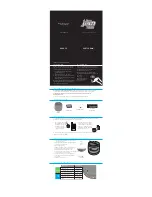
Paradigm
®
Special Edition speakers are efficient and can be driven to loud
listening levels with moderate amplifier power. They are also able to handle
the output of very powerful amplifiers. To prevent damage to your speakers,
please read the following guidelines before hooking them up.
Amplifier Distortion—The #1 Culprit!
Amplifier distortion is the principal cause of speaker damage. When listening
at loud levels your amplifier may run out of clean power. It will then begin to
produce distorted power several times greater than its rated output power.
This will damage any brand of speaker very quickly!
(See dealer for amplifier
recommendations.)
More Powerful Amplifiers are Safer
A 40 watt/channel amplifier will have substantial distortion above 40 watts.
If driven to 50 watts, this amplifier will deliver distorted power—which
will damage the speaker! A 100 watt/channel amplifier will have substantial
distortion above 100 watts, but very low distortion below 100 watts. Therefore,
when the speaker requires 50 watts, this more powerful amplifier will deliver
clean power and speaker damage is less likely to occur.
Volume Control
Do not be fooled by the Volume Control of your receiver/preamplifier. It only
adjusts listening level—it is not a “power-output” dial. The amount of
amplifier power actually used at a given Volume Control setting depends
solely on the nature of the music you are listening to. At a given Volume
Control setting a quiet section of music will use less amplifier power than a
loud section. With typical pop-rock, jazz or large scale classical music, the rated
output power of many receivers/amplifiers is often reached when the
Volume Control is between the “11” and “1 o’clock” settings (with bass/ treble
and loudness controls not used—otherwise rated power may be reached at
even lower Volume Control settings).
Remember, all amplifiers produce distortion when operated beyond their rated
output power. The resulting distortion will damage all speakers! Exercise
caution! If you listen at loud levels, be careful to listen for the point of audible
distortion—if the speakers begin to sound distressed, turn the Volume Control
down or your speakers and/or amplifier(s) will be damaged!
This type of
damage constitutes abuse and is not covered by the warranty.
If
louder volumes are desired, obtain a more powerful amplifier.
There is a Limit!
Although more powerful amplifiers are safer, there is a point at which you
could have more power than the speaker can handle. At that point you will
overpower the speaker and damage it. Exercise caution! At loud levels do
not increase bass/treble controls from zero and ensure that all loudness/
contour/bass EQ buttons are off (otherwise rated output power will be
reached at lower volume control settings). If you listen at loud levels,
watch for excessive visible cone excursion (grille movement) from the
woofer—then turn the Volume Control down.
The Right Amount of Power
A power-range rating is given as a guide to indicate the approximate
minimum and maximum power input of your Paradigm® Special Edition
speakers. Amplifiers that exceed your speaker’s power-range rating are
recommended. Their greater power reserves provide better sound. However,
exercise caution! Use the speakers within their power-range rating to prevent
damage (keep listening levels below the point of excessive woofer cone
excursion).
PREVENTING SPEAKER DAMAGE
11
Summary of Contents for SE series
Page 1: ...OWNERS MANUAL PARADIGM ELECTRONICS INC MAN0001004 111109 w w w p a r a d i g m c o m...
Page 10: ...SUB IN LFE IN Fig 15 SUBWOOFER CONNECTION SUBWOOFER PLACEMENT Fig 14 9 Fig 13a Fig 13b Fig 13c...
Page 22: ...NOTES...
Page 23: ...MODE D EMPLOI MD PARADIGM ELECTRONICS INC MAN0001004 111109 w w w p a r a d i g m c o m...
Page 44: ...REMARQUES...













































